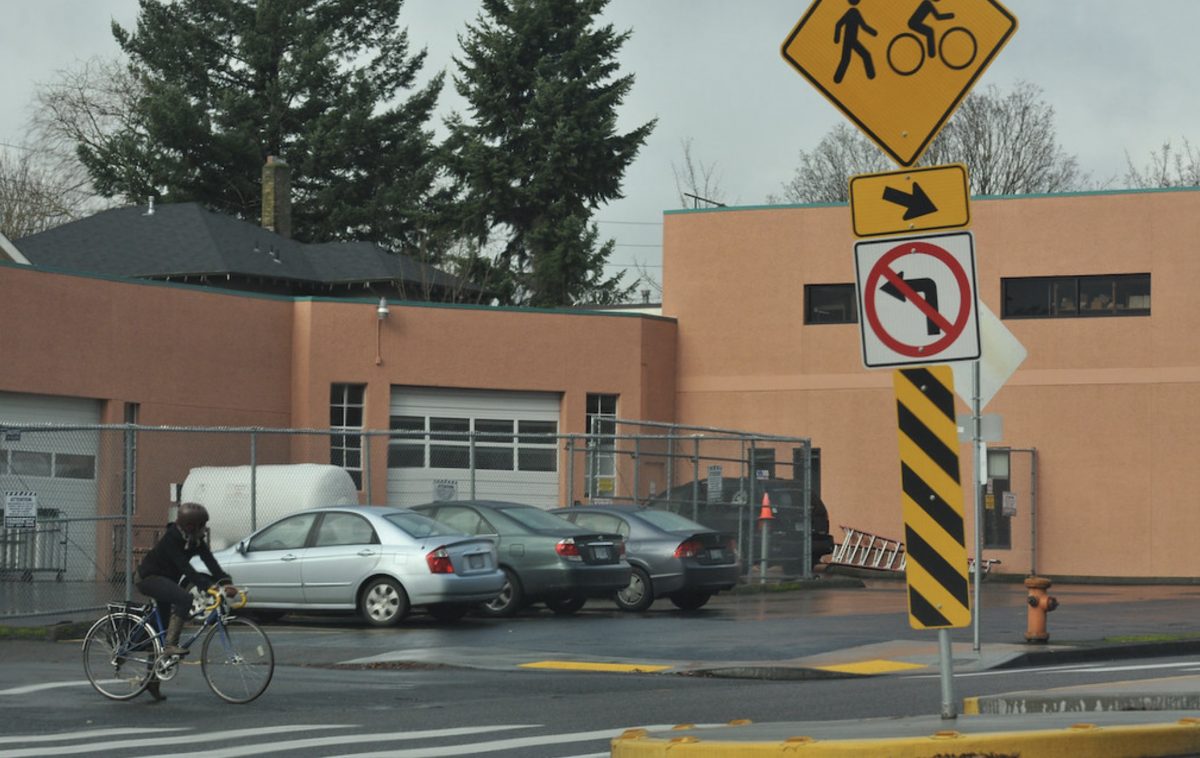
(Photo: Jonathan Maus/BikePortland)
A notorious crossing on Portland’s marquee neighborhood greenway is finally getting a traffic signal.
At their meeting Wednesday Portland City Council will pass an ordinance (PDF) that authorizes the transportation bureau to move forward on several crossing projects including a new traffic signal at Northeast Martin Luther King Jr. Blvd and Going Street.
This intersection sees around 2,000 average daily bicycle trips (extrapolated from hourly 2019 PBOT bicycle counts five blocks east) and it’s a key east-west connection between the Alberta area and the Vancouver/Williams corridor. PBOT added median islands and caution signage in 2010 to improve conditions for bicycle riders; but with two lanes in each direction, drivers on Martin Luther King Jr Blvd. still pose a (double) threat. MLK (also known as Highway 99E) is an arterial with high traffic volumes and a 30 mph speed limit.
Below are views of the intersection from MLK,
and from Going:
Concerns about this crossing have been well-known for many years. In 2012 we published an article by noted local traffic law expert and lawyer Ray Thomas that revealed his concerns. Thomas considers it an “ambiguous intersection” and wrote that it, “creates a troublesome situation for those it most seeks to help, as bicyclists are encouraged to assert a right of way they do not possess by law.” Thomas believes Oregon law doesn’t require auto users to stop at the crossing, but since many do — and because many bicycle riders might feel they have the right-of-way — confusion can too often lead to collisions.
The new signal will hopefully end that confusion and improve safety for greenway users.
Advertisement
In 2017 PBOT gathered public feedback about how to best spend a new pot of revenue from the 10-cent gas tax increase that’s known as the Fixing Our Streets program. After hearing from students and families in every local public school cluster and working with nonprofit Oregon Walks on a series of community events, they learned, “Street crossings are the biggest barriers students face walking to school.”
That process led to the identification of several projects. With council’s blessing Wednesday, PBOT will begin procurement for this signal on Going and at four other locations including: E Burnside and 16th (a man was killed two blocks east on this intersection in September), SE Washington and 86th, SE 148th and Main, and NE Glisan and 113th. They’ll also move forward on a project to add street lighting on Glisan between NE 82nd and 162nd (city limits) as well as build related ADA updates.
In addition to Fixing Our Streets, the projects are funding by cannabis tax revenue and system development charges.
— Jonathan Maus: (503) 706-8804, @jonathan_maus on Twitter and jonathan@bikeportland.org
— Get our headlines delivered to your inbox.
— Support this independent community media outlet with a one-time contribution or monthly subscription.



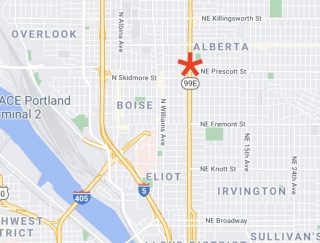

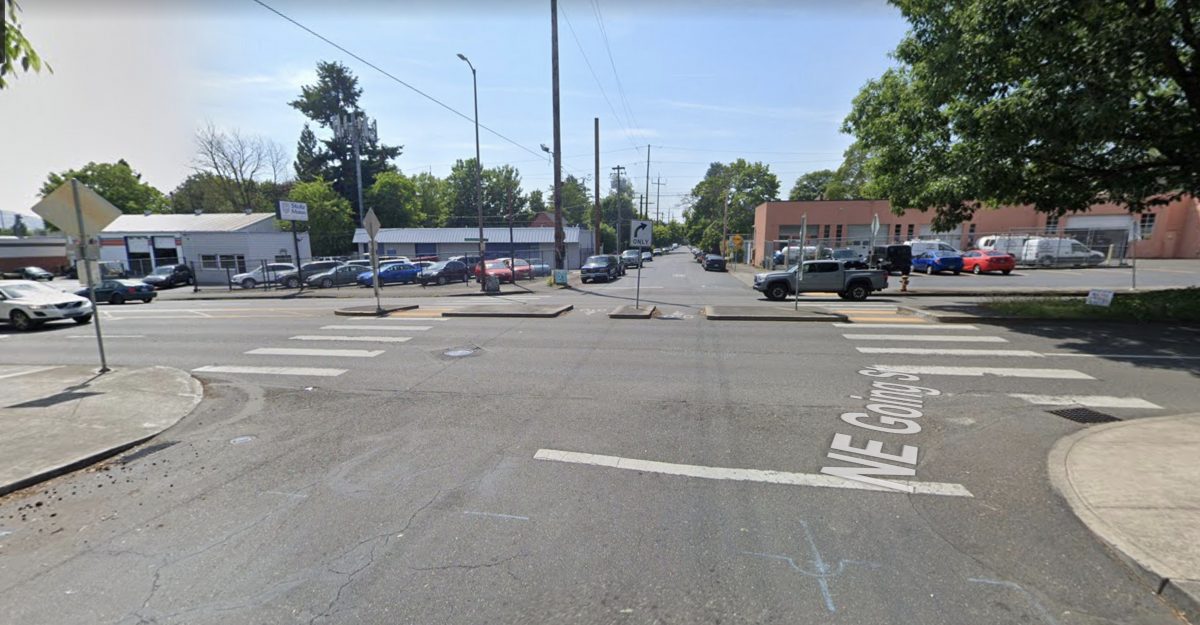


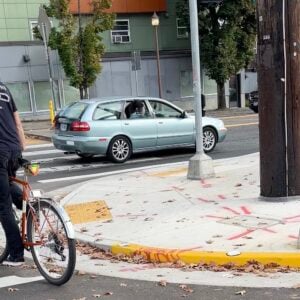
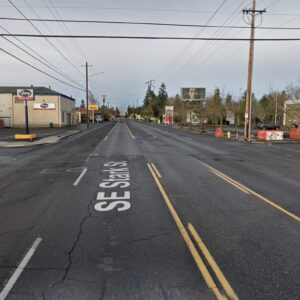
Thanks for reading.
BikePortland has served this community with independent community journalism since 2005. We rely on subscriptions from readers like you to survive. Your financial support is vital in keeping this valuable resource alive and well.
Please subscribe today to strengthen and expand our work.
SE Washington @ 86th has a blind corner, hence the need for a signal, on the 80s bikeway. NE 113th @ Glisan I used often when I lived nearby, definitely needs a signal – northbound 113th may look like a deadend on the map, but it actually connects with the HOP past a concrete barrier. SE 148th was designed to be a 6-lane expressway to connect to the Mt. Hood freeway, but is now a super-wide 2-lane with onstreet parking (rarely used) and bike lanes – designed for speed rather than safety. There’s a signal at Market but not at Main.
David, not trying to attack you here…but what do you do in NC? You comment here *endlessly*. I live here and can’t be bothered to chime in most the time. I think you offer a lot of good commentary, so thanks, but for real, what the hell?
Anyone remember Adam H? That was some prolific posting.
I do remember that guy, he did post a ton, then one day he vanished.
Oh man, yeah, he posted a lot. Wonder if he’s still in town. I remember being a little put off by him as I seem to recall him having just moved here. It’s admirable to dive right into the community and want to change things for the better, but sometimes it rubbed me the wrong way; “dude, you JUST moved here. you’re not a Portlander!” Plus I believe he bought a house on Clinton with his out of town money and I was saving pennies and living with housemates (and when I finally did buy it was way out in outer SE exile) These are my issues obviously, I’m pretty incredible, but not perfect.
This is darn funny!
Well, I respect his privacy, but it’s not hard to put the pieces together. I mean, there must be 100s if not 1000s of “Jasons” in PDX. But there will only ever be one David Hampsten.
Actually, there are about 10 nationwide that I know of, and at least 2 are distant cousins. I’m originally from ND, have lived and gone to school in Eugene OR and Morgantown WV. I lived in Portland from 1997 through 2015, got a MURP from PSU in 2003, worked as a low-level peon at PBOT 2000-2006 and briefly at planning. I’ve been unemployed since July 1 2008. I was an active community transportation advocate in East Portland 2008-2015, serving on EPAP and the Hazelwood NA board for most of that time. I also served on the PBOT budget/bureau advisory committee 2009-2015 and the BAC 2014-2015. I played in big role in the 2012 EPIM study and coined the terms 4M and HOP for those bike routes, though the routes themselves were created by others. I helped get about $400 million in EP projects funded (and some in SW too). I left Portland in late 2015 because I could no longer afford it. I moved to Greensboro NC, a much more affordable and warmer community (warmer in lots of ways) were I continue to do bike, walk, and transit advocacy and serve on the local transit commission, but I also do some statewide advocacy.
Damn the privacy, full speed ahead!
I hope you have a prominent display for your “Independent Spirit” Spirit of Portland award.
2013, also known as the Portland Neighborhood Asshole of the Year Award. Glass engraved, packed away in a box somewhere, not very useful here in NC. Portland? You mean like in Maine?
Like that, but in Oregon.
David, I can’t reply to your bio post. Thank you. You could have easily, and justifiably said, “Go to Hell, PTB”. I wouldn’t have fussed.
No, actually as a transportation advocate who is often in the public sphere, I’m happy to reply, but there’s a 3-hour time difference or time lag between where I live and Portland (it’s 3 hours later here), so my replies are often not immediate.
What a silly waste of money! For one, ODOT should be paying for this, not PBOT. For 2, the Going greenway is a tortured mess of an indirect route between Michigan and NE 7th with unsafe crossings at Mississippi, Vancouver, Williams and MLK. PBOT should remove the parking and continue the biffred bike lanes between N Michigan where they end to NE 7th. That would create a flat, direct connection that uses existing intersection controls at Mississippi, Vancouver, Williams, MLK and NE 7th! For roughly the same money as a new signal, a safe and functional connection for people biking could be created..
I agree. Getting ODOT to pay for anything aside from a freeway expansion is near impossible. Frankly, they don’t care about making highways safe or usable for any use aside from cars. Your tax dollars at work.
Hey now, they were more than willing to spend $200k on a pointless feasibility study to provide ferry service! Of course that money could have been spent on one their dozens of dangerous ped crossings but oh well.
A lot of people are excited about the idea of the ferry. I’m personally so excited I texted all my friends about it.
Doesn’t make it any less infeasible and stupid. When it doesn’t come about, we can lament how we could have used that $200k to upgrade pedestrian crossing on Lombard instead of paying it to some consultant.
The exception to prove the rule?
This section of MLK is a City of Portland (PBOT) street that ODOT upgraded to city specs then transferred to the city years ago.
Why would ODOT pay for a signal on a PBOT road? MLK hasn’t been a state-owned street for decades.
ODOT owns Highway 99E, does it not?
Nope, not this portion of 99E. ODOT owns the part called McLoughlin Blvd to the south of the viaduct, and they own MLK north of Lombard. But everything in between is owned by PBOT. Lots of segments of numbered highways are owned and maintained by the cities they go through, all throughout Oregon.
I didn’t know that, thanks for the education!
I’ve lived a block from Going since 2000, living between mississippi and 26th – I honestly do not have a problem with any of those crossings. Vancouver and Williams are never a problem and if you have trouble crossing Albina/mississippi at Going I don’t know what to say. I’ve crossed there multiple times a day for 7 years and can’t say I’ve felt unsafe crossing there on a bike, with a baby, with a dog, jogging. All those crossings have great sight lines.
To each their own I guess.
100% disagree. This intersection is highly utilized by a wide range of cyclists, from confident daily commuters to families with young children. The ambiguity is a real threat. Adding a signal is a big relief for me personally. A waste of money? Perhaps the best spend PBOT has done in recent memory.
I get that the MLK/Going intersection is heavily used now, and that this signal would be an improvement. My point is that fixing THIS intersection is just doubling down on a greenway route that has whole string of deficiencies. IMO, a successful bike route is safe and direct and comfortable. The Going/Blandena route between 7th is a mess that forces people on bikes to bike out of direction, follow a poorly signed and convoluted route, and negotiate uncontrolled intersections. Instead of spending money fixing one intersection, imagine if PBOT changes the route of Going Greenway to travel on Skidmore between NE 7th and connect to the buffered bike lanes at N Michigan. This would be a straight,, mostly flat and direct route with already controlled intersections at MLK, Vancouver, Williams, and Mississippi plus a nice bridge over I-5. The route would have 6′-7′ wide buffered bike lanes like what was installed on Skidmore between Interstate Ave and N Michigan. As a transportation link, the going/Blanda route is fatally flawed by being indirect and hard to follow and expensive to add the controlled intersections necessary to make this route a 8-80 appropriate. There are very few safe and direct connections between N and NE Portland for people biking. Barriers include Interstate Ave, I-5, Vancouver, Williams, and MLK. Skidmore bike lanes would be a transformative transportation link allowing people on bikes to safely and efficiently connect neighborhoods and business districts. So, I appreciate the potential safety improvement of a signal at MLK, but I recognize that this PBOT doubling down on a route that is inherently flawed and it will make it even less likely that they will connect the bike lanes on Skidmore.
Skidmore is too busy west of MLK to make a good bike route (I live on NE 10th & Skidmore). There is also a dangerous crossing at NE 15th that would need to be addressed. It makes a lot more sense to install a crossing signal at MLK & Going, rather than try to reconfigure Skidmore St through two busy commercial areas (N Williams & Mississippi) with lots of truck traffic and narrow intersections.
Not to mention the dogleg on 14th – best to have your head on a swivel when you negotiate this east/west blind spot. The incline (and steep drop right past the intersection) means that SB cars are moving quick and gathering speed at exactly the critical visual point.
I like Going, it gives me the opportunity to practice my cold-eyed stare at drivers who are itchin’ to blast through the stopsigns at all the NS intersections!
This is a Greenway, mofo! Bike coming through! 🙂
I have no desire to bike that close to cars on Skidmore. Taking Blandena is the way to go for me. I would like to see the car parking removed on Vancouver, so that you could turn right from Going onto a protected bike lane on Vancouver (opposite direction as traffic) and then turn left onto Blandena.
That would be super useful to have that little contraflow connection from Going to Blandena at Vancouver! I see people doing that all the time anyway, why not formalize and legalize it.
This section is NOT part of OR Highway 99E. It was handed over to the City of Portland years ago. It’s not ODOT’s, despite what the article implies.
The maps all have it labeled as 99E. Do you have a source for this? I’m just curious what would make ODOT let go of this one stretch of road, how far that stretch of road runs, and why they didn’t do it with other, more contentions roads. Such as HWY 26 / Powell.
ODOT actually is going to transfer Hwy 26 (Powell) from I-205 to City Limits to the City of Portland in a few years, once they complete upgrades. State-owned highways get transferred to cities fairly often, as long as the state pays to get them to a state of good repair so the city feels comfortable taking it off their hands. The highway number (99E, 26, etc) doesn’t really matter, it’s just a form of wayfinding. The City can own and maintain the highway and still keep the highway number.
Technically Naito Parkway and the Steel Bridge and Interstate Ave are still 99W, believe it or not! But none of them are owned by ODOT. Weirdly, ODOT still has a lease in place on the Steel Bridge deck, but that’s a remnant from the old Harbor Drive days.
Thanks, I was unaware. It makes sense in the big picture, and explains why there was such a tussle over Powell/26. Sort of funny though, I suspect the bike path will come back (on SE 28th) after the transfer.
Speaking as a troglodyte, how did you acquire this knowledge. Better yet, how would I go about finding the thread?
Ray Thomas’ obsession with the rule “law” is no surprise given his wealth and his membership in the bar. However, these facilities are not illegal and Thomas’ repeated criticisms of crossbikes and diversion treatments show a disdain for incremental infrastructure that makes cycling intersections more visible to those who drive. Unfortunately, Thomas has also repeatedly intimated that these treatments increase risk of injury or death without providing a shred of evidence to support this fearmongering. As an experienced and prominent “roadie”, Thomas may consider the status quo a better bet than one with pervasive diversion or use of crossbikes but I doubt the average “interested but concerned” cyclist would agree (design of these facilities can, of course, be improved).
Some of the rights that people on bikes currently possess came about because people asserted a “right” that they did not “possess by law”. Furthermore, chastising those who seek to create new “rights” (that are a hallmark of cities with high cycling mode share), not only discourages those who are willing to push aside barriers but plays into the hands of those who view people on bikes as lesser road users.
I agree. I don’t understand the concern here. Yes, drivers are under no legal obligation to yield to a bicyclist in this situation. But if drivers choose to yield, what’s wrong with that? In my experience the yielding is very good at Going & MLK. I still support this signal because it will make it even safer and will also benefit pedestrians, but it functions fairly well today because many drivers choose to yield. The idea that people should only do what’s strictly legal is bizarre. The yielding laws only tell you the minimum you are required to do–they don’t prevent you from yielding as an optional choice.
What’s wrong with that is that one driver yields, and you start crossing, and another doesn’t, and you get hit and now it’s your fault.
Or even better, you happen to find yourself in the undesirable position of driving during the evening commute. You happen to yield at one of these zebra crossings, and all the motorists around you honk and shake their fists. I mean, the silver lining to driving a death machine is stopping and letting humans cross the street. Ultimate power… staging a one person “yield in”.
What I do in that situation is wait until the drivers in both lanes yield.
…and hopefully the first car doesn’t get fed up waiting for the cyclist. :/ Ah, the price of safety.
“What I do in that situation is wait until the drivers IN ALL 4 LANES yield.”
FIFY.
Sorry, I was specifically thinking of SW 16th and SW Belmont. A drag strip is a quarter mile right, you would believe it by the way people driver from SE 12th to SE 17th! That one little hill plays host to a lot of races.
My understanding is that once one driver stops at a crosswalk, then other drivers traveling in the same direction must also stop. ORS 811.020. Whether the cyclist is actually in the crosswalk, or in the street between the crosswalks doesn’t matter once one car stops. I trust Ray’s reading of the law, but wonder if a cyclist would be found at fault if struck by a car while others cars were stopped.
The problem is that a crossbike is not a crosswalk, despite looking misleadingly similar. Also, probably incidentally, that statue specifically calls out pedestrians, which may not mean cyclists.
I understand what you are referring to, but I’m not sure whether that applies in this context. It might. Regardless, the law specifically refers to crosswalks, and crossbikes are not crosswalks, so no one gets the protection.
Some of what you say is true, but that won’t help you when you get creamed at one of these crossings and fail to get an insurance payout due to the legal grey area they create.
Personally, I haven’t had issues at this crossing, but I am hyper-aware of the adjacent lane issue. It is definitely a problem, and several pedestrians have been killed in Portland at marked crossings when this adjacent lane phenomenon occurs.
I think you misunderstand Thomas’ concerns. If you assert a right to cross that you don’t have, and you get hit, you will be considered at fault for the collision. He is saying nothing about whether the laws should be changed, or chastising people who want to change them, only warning about what the law actually says as opposed to what you wish it said.
But why is that a valid criticism? Is the design actually encouraging anyone to behave unsafely? Is there any research to indicate that cross-bikes or median cut-outs actually result in more crashes than not having them?
If crossbikes encourage people to more boldly assert a right-of-way that is no theirs, then yes, that would create conflict and be dangerous. I don’t think anyone is critical of the median cutouts.
I’m not aware of any research on cross-bikes. I think that they’re a Portland-only concept. Not sure if we can accurately judge their effects on safety yet. My dismount, smile and wave technique has been my go-to in many cases at intersections where people in cars often don’t stop.
Love it, can’t happen soon enough. Now let’s look at removing parking on Skidmore from Williams to Michigan to finish a low stress EW connection to the Max Station, Overlook and beyond
Mixed feelings on this one. I often avoid Going all together and cross at Skidmore or Shaver. I’d love to see a Skidmore/Shaver couplet between MLK and Interstate (or Mississippi for Shaver) with dedicated and separated bike lanes vs this mess at Going.
I don’t mind a good hill, but the Skidmore route isn’t that. I will drop that route and use Going exclusively if the MLK crossing is safe.
Typo: “In addition to Fixing Our Streets, the projects are funding by cannabis tax revenue and system development charges.”
Should be: “In addition to Fixing Our Streets, the projects are being funded by cannabis tax revenue and system development charges.”
Yay!!!!!!!!! Finally!
I crossed NE MLK at NE Going this morning. It’s not my only route but I use it a lot because it’s usually pretty quick. There many ways to catch a break in the traffic, whether because of a natural lull, an upstream red light, a car driver who gives up right of way, or a cyclist from the other side who plays the traffic island gambit and induces the MLK traffic to stop.
I’m agnostic about the value of ambiguity here. Sometimes 15-20 cars or trucks go past before there is a break. But, you never have to wait out a full light cycle on an open street.
If the signal is too annoying I’ll go another way.
I’d cross at NE Going if there was a light. I live about 1/2 mile from this crossing and most often choose to cross at the light on Alberta, and then cut down Grand past King to get on Going. I’ve never liked the crossing at Going. I’ve been a serious riding for 32 years, and the only predictable driving behavior I’ve observed is that drivers are unpredictable, now more than ever with cell phone/device distractions. Drivers understanding when they need/have to stop via a traffic light makes crossing ‘unambiguous’.
In my experience the NE MLK crossing at Morris St. is much more hazardous, with a signal, than the Going St. crossing, without a signal.
How can that be?
The signal at Morris is sensor activated so drivers are used to going through there at speed. When it does cycle to yellow and red there is a bad tendency to push the light several seconds into the red. Enforcement, anyone? This light needs a camera.
I believe the ambiguity of the situation at NE Going does make car drivers more cautious. It’s not too hard to guess who is going to stop.
I don’t understand why this is described as a notorious crossing. I’ve used if almost daily for over 10 years and have never found the lack of a signal to be an issue. This incident map doesn’t suggest a problem: https://www.arcgis.com/apps/MapSeries/index.html?appid=5385b143768c445db915a9c7fad32ebe
If anything, assuming a much higher volume of crossings at Going, there are far fewer conflicts here than nearby signalized crossings. I fear a stop light will just slow legal crossings now that we on bikes have the yield at a stop sign option, and frustrate drivers on MLK even more, thus promoting more motorized traffic on neighborhood side streets. A button or sensor activated flash would be far better than a stop light, but either way I feel, and the data I’ve found supports, that this is a solution in search of a problem.
Might it be possible that PBOT is trying to prevent incidents before they occur? Preventative maintenance, so to speak? The same map shows few or no incidents at most of the other intersections listed, but I know from my previous advocacy in East Portland that all the listed intersections there scare the crap out of most local walkers and family cyclists.
Speaking from personal experience having lived in NE Portland for 9+ years before being displaced into outer SE Portland, the crossing at Going and MLK Jr. Blvd is dangerous, problematic and counter to the outcomes of the active transportation network. In particular I can recall an incident in ~2009 crossing MLK Jr. Blvd at Going and the adjacent lane not yielding the right of way. To say that I was INCHES away from death would be an understatement. It is absolutely a notorious crossing on a recommended greenway between NoPo and NE Portland. Signalized crossings of arterials should be codified into city policy for greenways with funding. This signalized crossing is at least a decade behind when it was needed and needed to have been built many years before now.
Tone deaf.
There is no data in the City database within 5 blocks of this crossing in 2019 that could be used to ‘extrapolate’ to 2,000 bicycle trips per day.
The closest count is from 2015 near Garfield (west), and that was a count that distinguished between autos and bikes, so no extrapolation needed. The bike count was about 1,120 daily bike trips. West of MLK is a better predictor of MLK crossings than east of 7th.
Peak hour volumes are used to determine electronic traffic control based on volume, not daily counts. The PM peak in 2015 was about 190 cyclists. PBOT uses NCHRP 562 to gage the need for electronic interventions. The analysis done for this location found that rapid flashing beacons would serve up to 133 crossings per hour and above that volume a signal was recommended.
paikiala,
I got that figure from the 2019 bicycle counts. It was taken in late July at NE Going and 9th (a few blocks east) and says extrapolated daily is 2,130.
Finally, good news to hear!